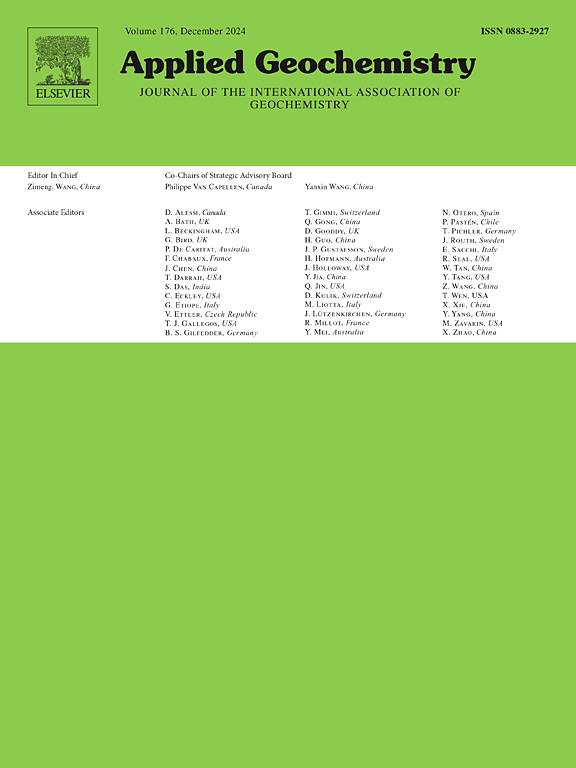Ligand exchange by As(V) enhanced desferrioxamine B-induced goethite dissolution: Insights into As mobilization in groundwater systems
IF 3.1
3区 地球科学
Q1 GEOCHEMISTRY & GEOPHYSICS
引用次数: 0
Abstract
The dissolution of As-bearing Fe(III) (oxyhydr)oxides is the key process leading to arsenic (As) enrichment in groundwater, which can be enhanced by organic ligands secreted by microorganisms, such as siderophores. However, the roles of organic ligand-induced dissolution of Fe(III) (oxyhydr)oxides in As mobilization are poorly understood. To address this issue, we examined the dissolution kinetics of pure goethite, As(V)-bearing goethite, and As(III)-bearing goethite induced by the trihydroxamate siderophore desferrioxamine B (DFOB) under anoxic conditions and the associated impact of As mobility. DFOB-induced goethite dissolution followed classic surface-controlled dissolution kinetics. As(V) promoted DFOB-induced goethite dissolution, which was attributed to the presence of Fe-As(V) complexes acting as ligand shuttles. However, As(III) slightly inhibited DFOB-induced goethite dissolution, due to the smaller surface area of narrow and rounded (021) crystal facets of As(III)-bearing goethite. Moreover, during DFOB-induced dissolution of As-bearing goethite, the percentages of released As to total As adsorption in DFOB-As(V)-Gt series (13.85 ± 1.52%) were significantly higher than those (9.82 ± 4.66%) in DFOB-As(III)-Gt series, which were linearly positively correlated with goethite dissolution. Therefore, the present findings emphasized the importance of organic ligand-induced dissolution of As-bearing Fe(III) (oxyhydr)oxides as a potential pathway for mobilizing As in groundwater systems.

As(V)的配体交换增强了去铁胺b诱导的针铁矿溶解:地下水系统中As动员的见解
含砷铁(III)(氧)氧化物的溶解是导致地下水中砷(As)富集的关键过程,微生物分泌的有机配体(如铁载体)可以增强砷(As)富集。然而,有机配体诱导的Fe(III)(氧合)氧化物溶解在As活化中的作用尚不清楚。为了解决这一问题,我们研究了三羟酸铁载体去铁胺B (DFOB)在缺氧条件下诱导纯针铁矿、含As(V)针铁矿和含As(III)针铁矿的溶解动力学以及As迁移率的相关影响。dfob诱导针铁矿溶解遵循经典的表面控制溶解动力学。As(V)促进了dfob诱导的针铁矿溶解,这是由于Fe-As(V)配合物作为配体穿梭体的存在。然而,由于含As(III)的针铁矿的窄圆(021)晶面表面积较小,因此,As(III)对dfob诱导的针铁矿溶解有轻微的抑制作用。此外,在DFOB-As(V)-Gt系列中,释放As占总吸附As的比例(13.85±1.52%)显著高于DFOB-As(III)-Gt系列(9.82±4.66%),二者与针铁矿溶解呈线性正相关。因此,目前的研究结果强调了有机配体诱导含砷铁(III)(氧合)氧化物溶解作为地下水系统中砷动员的潜在途径的重要性。
本文章由计算机程序翻译,如有差异,请以英文原文为准。
求助全文
约1分钟内获得全文
求助全文
来源期刊

Applied Geochemistry
地学-地球化学与地球物理
CiteScore
6.10
自引率
8.80%
发文量
272
审稿时长
65 days
期刊介绍:
Applied Geochemistry is an international journal devoted to publication of original research papers, rapid research communications and selected review papers in geochemistry and urban geochemistry which have some practical application to an aspect of human endeavour, such as the preservation of the environment, health, waste disposal and the search for resources. Papers on applications of inorganic, organic and isotope geochemistry and geochemical processes are therefore welcome provided they meet the main criterion. Spatial and temporal monitoring case studies are only of interest to our international readership if they present new ideas of broad application.
Topics covered include: (1) Environmental geochemistry (including natural and anthropogenic aspects, and protection and remediation strategies); (2) Hydrogeochemistry (surface and groundwater); (3) Medical (urban) geochemistry; (4) The search for energy resources (in particular unconventional oil and gas or emerging metal resources); (5) Energy exploitation (in particular geothermal energy and CCS); (6) Upgrading of energy and mineral resources where there is a direct geochemical application; and (7) Waste disposal, including nuclear waste disposal.
 求助内容:
求助内容: 应助结果提醒方式:
应助结果提醒方式:


